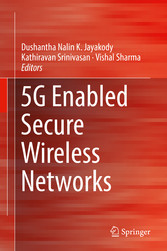Suchen und Finden
Service

5G Enabled Secure Wireless Networks
Dushantha Nalin K. Jayakody, Kathiravan Srinivasan, Vishal Sharma
Verlag Springer-Verlag, 2019
ISBN 9783030035082 , 214 Seiten
Format PDF, OL
Kopierschutz Wasserzeichen
Foreword
6
Preface
8
Acknowledgment
11
Contents
13
5G Security: Concepts and Challenges
17
Abbreviations
17
1 Overview
19
1.1 Introduction
19
1.2 Evolution of Cellular Technologies
19
First Generation
20
Second Generation
20
Third Generation
21
Fourth Generation
22
Fifth Generation
22
1.3 The Significance of 5G Security
23
1.4 The Need for Security
24
2 5G Security Standardization
24
2.1 Internet Engineering Task Force
25
3 Security Characteristics of 5G
26
3.1 Drivers of 5G
26
3.2 Significance of Security and Privacy
27
Modern Confide Models
27
Security for New Relevance Transmission Models
27
Emerging Risk Prospects
28
Raised Privacy Concerns
28
4 Network Planning
29
4.1 Objectives
29
4.2 Planning Inputs
30
Traffic Models
30
Potential Site Locations
31
BS Model
31
Propagation Prediction Models
31
4.3 Planning Outputs
32
4.4 Types of Network Planning
32
Rollout Network Planning
32
Incremental Network Planning
32
5 5G Roadmap
33
5.1 Need for Roadmap
33
5.2 Roadmap Process
34
6 Existing Concepts of 5G
34
6.1 Multiple Input and Multiple Output
34
6.2 Cognitive Radio Network
35
7 Security Models
36
7.1 Identity Management
37
7.2 UE Security
37
7.3 Radio Network Security
38
7.4 Flexible and Scalable Security
38
7.5 Network Slicing Security
38
7.6 Vitality Effective Security
39
7.7 Cloud Security
39
8 Security Protocols
40
8.1 Informal Security Protocols
40
Dolev-Yao Adversary
40
Threat Model
40
Security Properties
41
Authentication Properties for Protocols
41
Channels
42
Attack Scenarios
44
9 Channel Security
44
9.1 Introduction
44
9.2 Physical Layer Security Coding
45
LDPC Codes
45
Polar Codes
46
Lattice Codes
47
9.3 Massive MIMO
48
Passive Eavesdropper Scenarios
48
Active Eavesdropper Scenarios
48
9.4 Millimeter Wave (mmWave) Communications
50
9.5 Heterogeneous Networks
51
Physical Layer Security in Heterogeneous Networks
51
9.6 Non-orthogonal Multiple Access (NOMA)
52
Physical Layer Security of NOMA
52
9.7 Full Duplex Technology
53
Full Duplex Receiver
53
Full Duplex Base Station
54
Full Duplex Eavesdropper
54
References
56
5G Applications and Architectures
60
Brief Summary
60
1 Brief Introduction to 5G
61
2 Applications
61
3 Novel Architectures and Implications
62
4 Cross-Layer Design
67
5 SDN-NFV-Based Models
69
5.1 Software-Defined Network (SDN)
69
5.2 Network function virtualization (NFV)
74
NFV Infrastructure
74
Virtualized Network Framework (VNF)
74
Management and Network Orchestration (MNO)
74
OSS"026E30F BSS Layer
76
6 Service Architectures and Potential Direction
76
6.1 Industry Initiatives
76
7 Conclusion
78
Appendix
79
NEMO
79
References
79
A Survey on the Security and the Evolution of Osmotic and Catalytic Computing for 5G Networks
84
1 Introduction
84
1.1 Applications of 5G Networks
85
1.2 Attacks and Threats in 5G Networks
87
2 Preliminaries: Osmotic Computing
87
3 Preliminaries: Catalytic Computing
90
4 Existing Surveys and Their Applicability
90
5 Taxonomy of Security Concerns for 5G Networks
92
5.1 Secure Resource Allocation in 5G
92
5.2 Secure Mobility Management in 5G
95
5.3 Secure Routing in 5G
98
5.4 Secure Physical Layer Formations in 5G
100
5.5 Secure Autonomous and Smart Services in 5G
102
6 CATMOSIS: A Generalized Model for 5G Security
104
7 Open Issues and Future Directions
106
8 Conclusions
109
References
110
Physical Layer Security in 5G Hybrid Heterogeneous Networks
118
1 Introduction
118
2 Background
119
3 The System Layout
120
4 System Performance Evaluation
126
4.1 Achievable Rates
126
4.2 Physical Layer Security Parameters
127
5 Simulation Results and Performance Analysis
128
6 Conclusion
133
References
134
Physical Layer Security of Energy Harvesting Machine-to-Machine Communication System
137
1 Introduction to Machine-to-Machine Communications
137
1.1 Applications of M2M Communications
138
1.2 Design and Performance Analysis of M2M Communications
140
1.3 M2M Security Challenges and State-of-the-Art Solutions
140
2 Energy Harvesting
141
2.1 Energy Harvesting Sources
142
2.2 RF Energy Harvesting
143
Recent Developments in Wireless Power Transfer
144
3 Principles of Physical Layer Security
145
3.1 Categorization of Eavesdroppers
145
Based on Cooperation
145
Based on Activity
146
3.2 Comparative Analysis of Secure Energy Harvesting Protocols
146
4 Secrecy Performance of Energy Harvesting M2M Networks
150
4.1 System Model
150
Assumptions
151
Dedicated Jamming
151
FD Destination-Assisted Jamming
153
4.2 Secrecy Outage Probability Analysis
156
Dedicated Jamming
156
FD Destination-Assisted Jamming
157
4.3 Results and Discussion
158
4.4 Conclusions
161
4.5 Future Research Directions
161
References
162
Beam-Domain Full-Duplex Massive MIMO Transmission in the Cellular System
168
1 Introduction
168
2 System and Channel Models
170
3 Beam-Domain Full-Duplex Transmission Scheme
174
3.1 Beam-Domain Channel Representation
174
3.2 Beam-Domain Full-Duplex Transmission
180
4 Practical Implementation of BDFD Scheme
184
4.1 K-Means-Based UE Grouping
184
4.2 Full-Duplex Effective Beam-Domain Channel Estimation
186
Uplink Effective Beam-Domain Channel Estimation
187
Downlink Effective Beam-Domain Channel Estimation
188
4.3 Beam-Domain Data Transmission and Achievable Rate with Noisy CSI
189
4.4 Interference Control Between Uplink and Downlink
193
5 Simulation Results
193
6 Conclusion
198
Appendix
198
References
202
Correction to: 5G Security: Concepts and Challenges
206
Index
207


